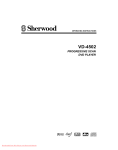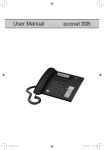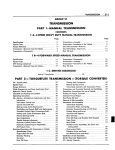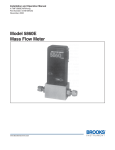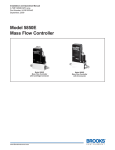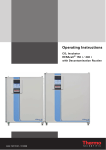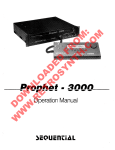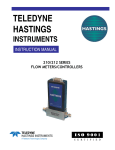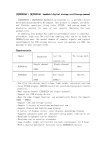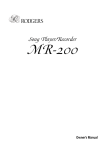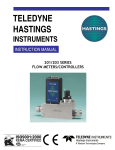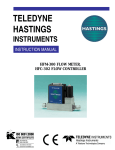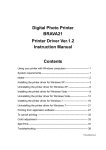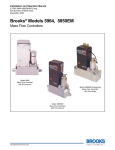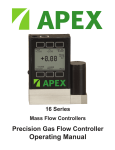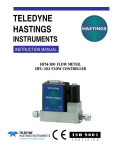Download X-TMF-5861E-MFM-eng Cover.pmd
Transcript
Installation and Operation Manual X-TMF-5861E-MFM-eng Part Number: 541B107AAG November, 2008 Model 5861E Mass Flowmeter Model 5861E Installation and Operation Manual X-TMF-5861E-MFM-eng Part Number: 541B107AAG November, 2008 Model 5861E Essential Instructions Read this page before proceeding! Brooks Instrument designs, manufactures and tests its products to meet many national and international standards. Because these instruments are sophisticated technical products, you must properly install, use and maintain them to ensure they continue to operate within their normal specifications. The following instructions must be adhered to and integrated into your safety program when installing, using and maintaining Brooks Products. • Read all instructions prior to installing, operating and servicing the product. If this instruction manual is not the correct manual, please see back cover for local sales office contact information. Save this instruction manual for future reference. • If you do not understand any of the instructions, contact your Brooks Instrument representative for clarification. • Follow all warnings, cautions and instructions marked on and supplied with the product. • Inform and educate your personnel in the proper installation, operation and maintenance of the product. • Install your equipment as specified in the installation instructions of the appropriate instruction manual and per applicable local and national codes. Connect all products to the proper electrical and pressure sources. • To ensure proper performance, use qualified personnel to install, operate, update, program and maintain the product. • When replacement parts are required, ensure that qualified people use replacement parts specified by Brooks Instrument. Unauthorized parts and procedures can affect the product's performance and place the safe operation of your process at risk. Look-alike substitutions may result in fire, electrical hazards or improper operation. • Ensure that all equipment doors are closed and protective covers are in place, except when maintenance is being performed by qualified persons, to prevent electrical shock and personal injury. Pressure Equipment Directive (PED) All pressure equipment with an internal pressure greater than 0.5 bar (g) and a size larger than 25mm or 1" (inch) falls under the Pressure Equipment Directive (PED). The Directive is applicable within the European Economic Area (EU plus Norway, Iceland and Liechtenstein). Pressure equipment can be traded freely within this area once the PED has been complied with. • Section 1 of this manual contains important safety and operating instructions related to the PED directive. • Meters described in this manual are in compliance with EN directive 97/23/EC module H Conformity Assessment. • All Brooks Instrument Flowmeters fall under fluid group 1. • Meters larger than 25mm or 1" (inch) are in compliance with category I, II, III of PED. • Meters of 25mm or 1" (inch) or smaller are Sound Engineering Practice (SEP). ESD (Electrostatic Discharge) Handling Procedure: 1. Power to unit must be removed. 2. Personnel must be grounded, via a wrist strap or other safe, suitable means before any printed circuit card or other internal device is installed, removed or adjusted. 3. Printed circuit cards must be transported in a conductive container. Boards must not be removed from protective enclosure until immediately before installation. Removed boards must immediately be placed in protective container for transport, storage or return to factory. Comments This instrument is not unique in its content of ESD (electrostatic discharge) sensitive components. Most modern electronic designs contain components that utilize metal oxide technology (NMOS, SMOS, etc.). Experience has proven that even small amounts of static electricity can damage or destroy these devices. Damaged components, even though they appear to function properly, exhibit early failure. Installation and Operation Manual X-TMF-5861E-MFM-eng Part Number: 541B107AAG November, 2008 Model 5861E Dear Customer, We appreciate this opportunity to service your flow measurement and control requirements with a Brooks Instrument device. Every day, flow customers all over the world turn to Brooks Instrument for solutions to their gas and liquid low-flow applications. Brooks provides an array of flow measurement and control products for various industries from biopharmaceuticals, oil and gas, fuel cell research and chemicals, to medical devices, analytical instrumentation, semiconductor manufacturing, and more. The Brooks product you have just received is of the highest quality available, offering superior performance, reliability and value to the user. It is designed with the ever changing process conditions, accuracy requirements and hostile process environments in mind to provide you with a lifetime of dependable service. We recommend that you read this manual in its entirety. Should you require any additional information concerning Brooks products and services, please contact your local Brooks Sales and Service Office listed on the back cover of this manual or visit www.BrooksInstrument.com Yours sincerely, Brooks Instrument Installation and Operation Manual X-TMF-5861E-MFM-eng Part Number: 541B107AAG November, 2008 Model 5861E THIS PAGE WAS INTENTIONALLY LEFT BLANK Installation and Operation Manual X-TMF-5861E-MFM-eng Part Number: 541B107AAG November, 2008 Paragraph Number Contents Model 5861E Page Number Section 1 Introduction 1-1 Purpose ...................................................................................................................................... 1-1 1-2 Description ................................................................................................................................. 1-1 1-3 Specifications ............................................................................................................................. 1-1 Section 2 Installation 2-1 Receipt of Equipment ................................................................................................................. 2-1 2-2 Recommended Storage Practice ................................................................................................ 2-1 2-3 Return Shipment ........................................................................................................................ 2-2 2-4 Gas Connections ........................................................................................................................ 2-2 2-5 Installation .................................................................................................................................. 2-2 2-6 In-Line Filter ............................................................................................................................... 2-4 2-7 Electrical Interfacing ................................................................................................................... 2-5 Section 3 Operation 3-1 Theory of Operation .................................................................................................................... 3-1 3-2 Operating Procedure .................................................................................................................. 3-2 3-3 Zero Adjustment ......................................................................................................................... 3-2 3-4 Calibration Procedure ................................................................................................................. 3-3 3-5 Response (Flow Output Signal) .................................................................................................. 3-6 Section 4 Maintenance 4-1 General ...................................................................................................................................... 4-1 4-2 Troubleshooting .......................................................................................................................... 4-1 4-3 Sensor Tube ............................................................................................................................... 4-4 4-4 Disassembly and Assembly ........................................................................................................ 4-4 4-5 Use of the Conversion Tables ..................................................................................................... 4-6 4-6 Restrictor Sizing ......................................................................................................................... 4-9 Section 4 Parts List 5-1 General ...................................................................................................................................... 5-1 Section A CE Certificate CE Certificate of Mass Flow Equipment .................................................................................................A-1 Warranty, Local Sales/Service Contact Information ....................................................................... Back Cover i Contents Model 5861E Installation and Operation Manual X-TMF-5861E-MFM-eng Part Number: 541B107AAG November, 2008 Figures Figure Page Number Number 2-1 Model 5861E Dimensions ........................................................................................................... 2-3 2-2 "D" Type Connector Pin Arrangement ......................................................................................... 2-3 3-1 Flow Sensor Operational Diagram .............................................................................................. 3-2 3-2 Model 5861E Calibration Connections ........................................................................................ 3-4 3-3 Adjustment Potentiometer Location ............................................................................................ 3-4 3-4 Fast Response Adjustment......................................................................................................... 3-4 4-1 Restrictor Element Assembly ..................................................................................................... 4-10 4-2 Restrictor Orientation in Meter Body .......................................................................................... 4-10 5-1 Model 5861E Parts Drawing ....................................................................................................... 5-2 Tables Table Page Number Number 2-1 Recommended Filter Size .......................................................................................................... 2-4 4-1 Bench Troubleshooting ............................................................................................................... 4-2 4-2 Sensor Troubleshooting .............................................................................................................. 4-2 4-3 Conversion Factors (Nitrogen Base) .......................................................................................... 4-7 4-4 Restrictor Selection Guide ......................................................................................................... 4-11 5-1 Model 5861E Replacement Parts List ......................................................................................... 5-3 5-2 Tool and Spare Part Kits for 5861E ............................................................................................. 5-4 ii Section 1 Introduction Installation and Operation Manual X-TMF-5861E-MFM-eng Part Number: 541B107AAG November, 2008 Model 5861E 1-1 Purpose The Brooks® Model 5861E Flowmeter is a mass flow measurement device designed for accurately measuring flows of gases. This instruction manual is intended to provide the user with all the information necessary to install, operate and maintain the Brooks 5861E Mass Flowmeter. This manual is organized into five sections: Section 1 - Introduction Section 2 - Installation Section 3 - Operation Section 4 - Maintenance Section 5 - Parts List It is recommended that this manual be read in its entirety before attempting to operate or repair the Model 5861E. 1-2 Description The Brooks Model 5861E Mass Flowmeter is used widely in the Semiconductor, as well as many other industries where manual, electronic, or computer controlled gas handling occurs. The Model 5861E consists of two basic units: a flow sensor and an integral electronic signal control system. This combination produces a stable gas flow indication, which eliminates the need to continuously monitor and compensate for changing gas pressures and temperatures. 1-3 Specifications Flow Ranges Any full scale flow rate from 10 slpm* to 100 slpm, Nitrogen equivalent (200 slpm H2). *Standard pressure and temperature in accordance with SEMI (Semiconductor Equipment and Materials Institute) standard: 0°C and 101.3 kPa (760 Torr). Ratings Maximum Operating Pressure: 1500 psi (103 bar) Ambient/Operating Temperature: 40°F to 150°F (5°C to 65°C) Non-operating: -13°F to +212°F (-25°C to 100°C) Performance Accuracy: ±1% full scale including linearity at calibrated conditions. Repeatability 0.25% of rate Response Time Less than 3 seconds 1-1 Section 1 Introduction Installation and Operation Manual X-TMF-5861E-MFM-eng Part Number: 541B107AAG November, 2008 Model 5861E Control / Usable Range 50 to 1 Sensitivity to Mounting Attitude ±0.5% F.S. maximum deviation from specified accuracy after rezeroing under 200 psig Temperature Sensitivity Zero: Less than ±0.075% F.S. per degree C Span: Less than ±1.0% F.S. shift from original calibration over 10-50°C range Pressure Sensitivity 0.03% per PSI up to 200 PSIG Power Supply Sensitivity ±0.09% full scale per % power supply voltage variation Output Signal 0 to 5 Vdc into 3000 ohms (or greater) load. Maximum ripple 3 mV Leak Integrity 1 x 10-9 atmosphere scc/sec. Helium Power Requirements +15 Vdc (±5%) at 35 mA dc -15 Vdc (±5%) at 35 mA dc 1.05 watts power consumption Materials of Construction Fittings and Transducer Assembly - Wetted parts 316 stainless steel O-rings and Gaskets - Standard: Viton® fluoroelastomers and Buna-N; Optional: Kalrez® Electrical Connections D-connector, 15-pin type (DA-15P) Dimensions See Figure 2-1 1-2 Installation and Operation Manual Section 2 Installation X-TMF-5861E-MFM-eng Part Number: 541B107AAG November, 2008 Model 5861E 2-1 Receipt of Equipment When the equipment is received, the outside packing case should be checked for damage incurred during shipment. If the packing case is damaged, the local carrier should be notified at once regarding his liability. A report should be submitted to the Product Service Department, Brooks Instrument, Hatfield, Pennsylvania 19440-0903. Remove the envelope containing the packing list. Carefully remove the equipment from the packing case. Make sure spare parts are not discarded with the packing materials. Inspect for damaged or missing parts. Brooks Instrument 407 W. Vine Street P.O. Box 903 Hatfield, PA 19440 USA Toll Free (888) 554-FLOW (3569) Tel (215) 362-3700 Fax (215) 362-3745 E-mail: [email protected] www.BrooksInstrument.com Brooks Instrument Neonstraat 3 6718 WX Ede, Netherlands P.O. Box 428 6710 BK Ede, Netherlands Tel 31-318-549-300 Fax 31-318-549-309 E-mail: [email protected] Brooks Instrument 1-4-4 Kitasuna Koto-Ku Tokyo, 136-0073 Japan Tel 011-81-3-5633-7100 Fax 011-81-3-5633-7101 Email: [email protected] 2-2 Recommended Storage Practice If intermediate or long-term storage is required for equipment as supplied by Brooks Instrument, it is recommended that said equipment be stored in accordance with the following: a. Within the original shipping container. b. Store in a sheltered area with the following conditions: 1. Ambient temperature 21°C (70°F) nominal. 2. Relative humidity 45% nominal, 60% maximum/25% minimum. Upon removal from storage, a visual inspection should be conducted to verify its condi-tion is “as received.” If the equipment has been in storage for an excess of ten (10) months or in conditions in excess of those recommended, all pressure boundary seals should be replaced and the device subjected to a pneumatic pressure test in accordance with applicable vessel codes. 2-1 Installation and Operation Manual Section 2 Installation X-TMF-5861E-MFM-eng Part Number: 541B107AAG November, 2008 Model 5861E 2-3 Return Shipment Prior to returning any Brooks equipment to the factory, contact the factory for a Return Materials Authorization Number (RMA#). This can be obtained at Brooks Instrument, Product Service Department, 407 West Vine Street, Hatfield, PA 19440-0903, or call toll free 1-888-554-FLOW (3569). Brooks Instrument 407 W. Vine Street P.O. Box 903 Hatfield, PA 19440 USA Toll Free (888) 554-FLOW (3569) Tel (215) 362-3700 Fax (215) 362-3745 E-mail: [email protected] www.BrooksInstrument.com Brooks Instrument Neonstraat 3 6718 WX Ede, Netherlands P.O. Box 428 6710 BK Ede, Netherlands Tel 31-318-549-300 Fax 31-318-549-309 E-mail: [email protected] Brooks Instrument 1-4-4 Kitasuna Koto-Ku Tokyo, 136-0073 Japan Tel 011-81-3-5633-7100 Fax 011-81-3-5633-7101 Email: [email protected] Also, completion of Form RPR003-1, Brooks Instrument Decontamination Statement, as well as, a Material Safety Data Sheet (MSDS) for the fluid(s) used in the meter, is required before any Brooks Personnel can begin processing the equipment. Copies of the form can be obtained at one of the locations above. 2-4 Gas Connections Standard inlet and outlet connections supplied on the Model 5861E are 3/ 8" compression fittings. Optional VCOTM and VCRTM connections are available upon request. Prior to installation, make certain all piping is clean and free of obstructions. Install the piping in such a manner that permits easy removal if the instrument is to be removed for cleaning or test bench troubleshooting. 2-5 Installation (Refer to Figures 2-1 through 2-2) 2-2 Installation and Operation Manual Section 2 Installation X-TMF-5861E-MFM-eng Part Number: 541B107AAG November, 2008 Model 5861E Figure 2-1 Model 5861E Dimensions PIN NO. 1 2 3 4 5 6 7 8 9 10 11 12 13 14 15 FUNCTION Cmd. Common (Command Pot "CCW") • 0-5 Volt Signal Output Supply Common Valve Off • +15 Vdc Supply -15 Vdc Supply Valve Test Point/Purge • Cmd. Input or Cmd. Pot "S" • Supply Voltage Common 0-5 Volt Signal Common +5 Volt Reference Output (Command Pot "CW") • Valve Override • Not Used Chassis Ground Remote Transducer Input* • COLOR CODE Black White Red Green Orange Blue Wht/Blk Red/Blk Grn/Blk Org/Blk Blu/Blk Blk/Wht Red/Wht Grn/Wht Blu/Wht NOTE: 1. Cable shield tied to chassis ground in meter connector. Make no connection on customer end. 2. All power leads must be connected to power supply. * Factory Activated Option. • These connections are used for the 5850E and 5851E Mass Flow Controllers. Make no connections to these pins. Figure 2-2 "D" Type Connector Pin Arrangement 2-3 Installation and Operation Manual Section 2 Installation X-TMF-5861E-MFM-eng Part Number: 541B107AAG November, 2008 Model 5861E Recommended installation procedures: a. The Model 5861E should be located in a clean dry atmosphere relatively free from shock and vibration. b. Leave sufficient room for access to the electrical components. c. Install in such a manner that permits easy removal if the instrument requires cleaning. When used with a reactive (sometimes toxic) gas, contamination or corrosion may occur as a result of plumbing leaks or improper purging. Plumbing should be checked carefully for leaks and the meter purged with dry Nitrogen before use. d. The Model 5861E Mass Flowmeter can be installed in any position. However mounting orientations other than the original factory calibration (see data sheet) will result in a ±0.5% maximum full scale shift after re-zeroing. e. When installing Flowmeters, be aware that sharp abrupt angles in the system piping directly upstream of the controller may cause a small shift in accuracy. If possible have at least 10 pipe diameters of straight tubing upstream of the Model 5861E Mass Flowmeter. 2-6 In-Line Filter It is recommended that an in-line filter be installed upstream from the controller to prevent the possibility of any foreign material entering the flow sensor or control valve. The filtering element should be replaced periodically or ultrasonically cleaned. Table 2-1 Recommended Filter Size Maximum Flow Rate Recommended Filter Size 10-30slpm Above 30 slpm 15 micron 30 micron Note: The above lists the maximum recommended porosity for each flow range. It is recommended that the minimum micron porosity that does not limit the full scale flowrate be used. 2-4 Installation and Operation Manual X-TMF-5861E-MFM-eng Part Number: 541B107AAG November, 2008 Section 2 Installation Model 5861E 2-7 Electrical Interfacing To insure proper operation the Model 5861E must be connected as shown in Figure 2-2. Note: There are several functions on the printed circuit board which are not used by the Model 5861E. Avoid making connections marked in Figure 2-2 which are marked •. Also, the plug-in jumpers on printed circuit board are not used by the Model 5861E and have no effect on performance. The following minimum electrical connections must be made for new installations: Chassis Ground 0-5 Volt Signal Common 0-5 Volt Signal Output +15 Vdc Supply -15 Vdc Supply Power Supply Common 2-5 Installation and Operation Manual Section 2 Installation X-TMF-5861E-MFM-eng Part Number: 541B107AAG November, 2008 Model 5861E THIS PAGE WAS INTENTIONALLY LEFT BLANK 2-6 Installation and Operation Manual Section 3 Operation X-TMF-5861E-MFM-eng Part Number: 541B107AAG November, 2008 Model 5861E 3-1 Theory of Operation The thermal mass flow sensing technique used in the 5861E works as follows: A precision power supply provides a constant power heat input (P) at the heater which is located at the midpoint of the sensor tube. (Refer to Figure 31) At zero or no flow conditions, the heat reaching each temperature sensor (one upstream and one downstream of the heater) is equal. Therefore, the temperatures T1 and T2 are equal. When gas flows through the tube, the upstream sensor is cooled and the downstream sensor is heated, producing a temperature difference. The temperature difference T2-T1 is directly proportional to the gas mass flow. The equation is: Where, ΔT = Cp = P m A = = = ΔT = A * P * Cp * m temperature difference T2 - T1 (OK) specific heat of the gas at constant pressure (kJ/kg-OK) heater power (kJ/s) mass flow (kg/s) constant of proportionality (S2-OK2/kJ2) A bridge circuit interprets the temperature difference and a differential amplifier generates a linear 0-5 Vdc signal directly proportional to the gas mass flow rate. The flow restrictor shown in Figure 3-1 performs a ranging function similar to a shunt resistor in an electrical ammeter. The restrictor provides a pressure drop that is linear with flow rate. The sensor tube has the same linear pressure drop/flow relationship. The ratio of the restrictor flow to the sensor tube flow remains constant over the range of the meter. Different restrictors have different pressure drops and produce controllers with different full scale flow rates. The span adjustment in the electronics affects the fine adjustment of the controller's full scale flow. 3-1 Section 3 Operation Installation and Operation Manual X-TMF-5861E-MFM-eng Part Number: 541B107AAG November, 2008 Model 5861E Figure 3-1 Flow Sensor Operational Diagram 3-2 Operating Procedure a. Apply power to the flowmeter and allow approximately 45 minutes for the instrument to warm-up and stabilize its temperature. b. Turn on the gas supply. c. Shut-off flow to the meter and observe the flowmeter's output signal. If the output is not 0mVdc (±10mVdc), check for leaks and if none are found, refer to the re-zeroing procedure in Section 3-3. d. Open valve to allow flow to pass through the meter.Monitor the flow output signal. 3-3 Zero Adjustment Each Model 5861E is factory adjusted to provide a 0 ±10mVdc signal at zero flow. After initial installation and warm-up in the gas system the zero flow indication may be other than the factory setting. This is primarily caused by changes in temperature between our calibration laboratory and the final installation. The zero flow reading can also be affected to a small degree by changes in line pressure and mounting attitude. 3-2 Installation and Operation Manual X-TMF-5861E-MFM-eng Part Number: 541B107AAG November, 2008 Section 3 Operation Model 5861E To check zero always mount the controller in its final configuration and allow a minimum of 20 minutes for the temperature of the controller and its environment to stabilize. Using a suitable voltmeter check the controller output signal. If it differs from the factory setting adjust it by removing the lower pot hold plug, which is located closest to the controller body. Adjust the zero potentiometer (refer to Figure 3-3) until the desired output signal is obtained. 3-4 Calibration Procedure NOTE 1: Calibration of the Model 5861E mass flowmeter requires the use of a digital voltmeter (DVM) a flow control valve or mass flow controller to set the flow rate and a precision flow standard calibrator such as the Brooks Vol-U-Meter®. It is recommended that the calibration be performed only by trained and qualified service personnel. NOTE 2: If the mass flow controller is to be used on a gas other than the calibration gas, apply the appropriate sensor conversion factor. ( Refer to Section 4-5). a. Adjust the anticipate potentiometer fully clockwise (20 turns). Then adjust the anticipate potentiometer 10 turns counter clockwise to center the potentiometer. This will provide a rough adjustment of this circuit and make the flow signal stable for calibration. b. Connect the DVM positive lead to the 0-5V signal output (pin 2 D-connector, refer to Figure 3-2) and the negative lead to circuit common (TP4). Adjust the zero potentiometer for an output of 0mV ±2mV. c. Increase the flow rate until the flow signal output equals 5.000V. Connect the DVM positive lead to TP2 (linearity voltage) and the negative lead to TP4 (circuit common). Adjust the linearity potentiometer for an output of 0.0V (zero volts). d. Connect the DVM positive lead to the 0-5V signal output (pin 2 of DConnector) and the negative lead to TP4 (circuit common). Adjust the actual flow rate to within ±2% of desired full scale flow. Measure the flow rate using suitable volumetric calibration equipment. Adjust the flow rate to the proper full scale flow. Adjust the span potentiometer (Refer to Figure 3-3) until the 05V signal output equals the flow signal voltage calculated above. e. Connect the DVM positive lead to TP1 (sensor voltage). The voltage at TP1 is -100 times the output voltage of the sensor. This voltage can range from -1.2 to -12 volts, however it is recommended that this voltage stay between -2.0 to -9.0 volts for proper operation. If the recommended voltage range exceeds this than the desired accuracy and/or signal stability may not be achieved. If one of the limits is reached check the restrictor sizing procedure. ( Refer to Section 4-6). 3-3 Section 3 Operation Installation and Operation Manual X-TMF-5861E-MFM-eng Part Number: 541B107AAG November, 2008 Model 5861E Figure 3-2 Model 5861E Calibration Connections * *Note: Not used for a 5861E Figure 3-3 Adjustment Potentiometer Location 3-4 Figure 3-4 Fast Response Adjustment Installation and Operation Manual Section 3 Operation X-TMF-5861E-MFM-eng Part Number: 541B107AAG November, 2008 Model 5861E f. Shut off the flow. Connect the DVM positive lead to flow signal output (pin 2 D-connector) and the negative lead to TP4. Readjust the zero potentiometer for an output of 0mV±2mV as necessary. g. Adjust flow rate for a flow signal output of 50% (2.500V) and measure the flow rate. Calculate the error as a percentage of full scale. Note: indicated flow rate can be found using the following formula: indicated flow rate = flow signal (out) 5.000 x full scale flow Example: What is the percent of full scale error when full scale is equal to 50 slpm? Measured flow rate = 25.75 slpm Indicated flow rate = 25 slpm h. Calculate the TP2 correction voltage: (error recorded in step g) x 0.450 volts Example: Error = -1.5% TP2 correction voltage = -1.5 x 0.450 = -0.675 volts New TP2 voltage = 0 volts + (0.675) = -0.675 volts i. Adjust flow rate for a flow signal output of 100% (5.000V). Connect the DVM positive lead to TP2 and the negative lead to TP4. j. Adjust the linearity potentiometer for an output equal to the new calculated TP2 voltage. Note: the output signal should be kept at 5.000 V during this adjustment. This can be done by varying the actual flowrate. k. Repeat steps d, e, f and g. 1. If the error recorded in step g is less than 0.5%, then the calibration procedure is complete. 2. If the error is greater than 0.5% set the flow rate for a flow signal output of 100% (5.000V). Connect the DVM positive lead to TP2 (linearity voltage) and the negative lead to TP4 (circuit common). Calculate a new TP2 voltage as follows: Example: Sensor error = 0.7% (found in step g) Measured TP2 voltage = -0.567 volts TP2 correction = 0.7 x 0.450 = 0.315 volts New TP2 correction = 0.315 + (-0..567) = 0.882 volts 3-5 Section 3 Operation Model 5861E Installation and Operation Manual X-TMF-5861E-MFM-eng Part Number: 541B107AAG November, 2008 3. Adjust the linearity potentiometer for an output equal to the new TP2 voltage and then repeat step k. Note: The voltage at TP2 can range from -10 to +3 volts, however, it is recommended that this voltage stay between -2.5 and +2.5 volts for proper operation. If the recommended voltage range is exceeded the desired accuracy and/or signal stability may not be achieved. If one of the limits is reached, check the restrictor sizing. Refer to section 4-6. 1 to 5 Vdc: 1 Vdc 0 to 20 mA: 0 mA 4 to 20 mA: 0 mA In the Safe State, the valve will be unpowered. This means that for Normally Closed valves, the valve will stay closed and for Normally Open valves, the valve will stay open. 3-5 Response (Flow Output Signal) To achieve the proper response characteristics the response compensation circuit must be adjusted. This adjustment is performed by observing the output signal of the meter when the flow is suddenly stopped. Place a metering valve upstream of the Model 5861E to control the flow rate. A Brooks NRSTM precision metering valve is well suited for this application. Also place a fast acting shut-off valve immediately downstream of the flowmeter. A solenoid valve is ideal for this, but a manual toggle valve will do. Keep the length of interconnecting tubing as short as possible between the valves and the Model 5861E since the tubing can have a dampening effect on the flow and the gas may not stop flowing the instant the downstream valve is closed as desired. Adjustment of the fast response circuit will not alter the steady state accuracy of the flowmeter as adjusted in Section 3-4. Note: This procedure requires an oscilloscope, chart recorder, or a DVM with a sample speed three samples per second or greater to monitor the rate of change of the output signal during the test. Monitor the output signal at pin 2 of D-Connector. TP4 may be used for circuit common. 3-6 a. With the shut-off valve open adjust the metering valve so that the output voltage of the Model 5861E is 4.050 to 5.000 Vdc. Allow the output to become stable at this setting. b. Close the shut off valve to stop the flow. Observe the output signal as it decays. c. The behavior of the output signal during the transition between 100% and 0% flow indicates the adjustment required of the anticipate potentiometer. Refer to Figure 3-4. 1. If the flow signal decays to -0.05 to -0.5V then rises to 0.0V, the anticipate potentiometer is properly adjusted. 2. If the flow signal decays rapidly and goes below -0.5V before rising to 0.0V, the anticipate potentiometer must be adjusted clockwise and steps a and b repeated. 3. If the flow signal decays slowly and does not go below -0.05V, the anticipate potentiometer must be adjusted counterclockwise and steps a and b repeated. Installation and Operation Manual X-TMF-5861E-MFM-eng Part Number: 541B107AAG November, 2008 Section 4 Maintenance Model 5861E 4-1 General No routine maintenance is required on the Model 5861E other than an occasional cleaning. If an in-line filter is used, the filtering element should periodically be replaced or ultrasonically cleaned. 2. Connect the instrument to a source of the same gas used for it's original calibration. Regulate the Setpoint to 100% flow and adjust the inlet and outlet pressures to calibration conditions. Verify that the output signal reaches its full scale value and stabilizes at that value. Vary the command voltage over the 1 to 100% range and verify that the output signal follows the Setpoint If possible, connect a flow measurement device to monitor the actual flow behavior and verify the accuracy of the mass flow instrument. If the mass instrument performs as described above, then it is functioning correctly and the problem may lie elsewhere. 4-1 Troubleshooting 4-1 Section 4 Maintenance Installation and Operation Manual X-TMF-5861E-MFM-eng Part Number: 541B107AAG November, 2008 Model 5861E Table 4-1 Bench Troubleshooting Trouble Possible Cause Check/Corrective Action Output stays at 0 Volts regardless of flow. Clogged Sensor. Clean sensor. Refer to cleaning procedure. Section 4-4. Output signal stays at +6.8V and there is no flow through the meter. Defective PC Board. Replace PC Board. Refer to Section 4-4. Defective Sensor. Replace Sensor Assembly. Refer to Section 4-4. Meter grossly out of calibration. Partially clogged sensor. Flow is higher than indicated. Clean sensor, refer to the cleaning procedure. Meter grossly out of calibration. Partially clogged restrictor. Flow is lower than indicated. Replace restrictor. Refer to Section 4-4. Meter output oscillates. Anticipate potentiometer out of adjustment. Adjust anticipate potentiometer. Refer to Section 3-4. Faulty pressure regulator. Check regulator output. Defective PC Board. Replace PC Board. Refer to Section 4-4. Table 4-2 Sensor Troubleshooting 4-2 Installation and Operation Manual X-TMF-5861E-MFM-eng Part Number: 541B107AAG November, 2008 Section 4 Maintenance Model 5861E A. System Checks The Model 5861E is generally used as a component in gas handling systems which can be quite complex. This can make the task of isolating a malfunction in the system a difficult one. An incorrectly diagnosed malfunction can cause many hours of unnecessary downtime. If possible, make the following system checks before removing a suspected defective mass flow controller for bench troubleshooting or return, especially if the system is new: 1. Verify a low resistance common connection and that the correct power supply voltage and signals are reaching and leaving the meter. The Break-out Board (refer to Table 5-2) listed in section 5 , will make this job much easier. 2. Verify that the process gas connections have been correctly terminated and leak checked. N Bench Troubleshooting 1. Properly connect the mass flow controller to a ±15 Vdc power supply, and connect an output signal readout device (4-1/2 digit voltmeter recommended) to (Pins 2 and 10 D-connector) (Refer to Figure 2-2). Apply power, and allow the flowmeter to warm up for 45 minutes. Do not connect to a gas source at this time. Observe the output signal and, if necessary perform the zero adjustment procedure (Section 3-3). If the output signal will not zero properly, refer to the sensor troubleshooting section and check the sensor. If the sensor is electrically functional, the printed circuit board is defective and will require replacement. 2. Connect the flowmeter to a source of the gas on which it was originally calibrated. Increase the flow until 100% indication (5.00Vdc) is achieved. Vary the flow rate over the 2 to 100% range and verify that the output signal follows the flow rate. If possible, connect a flow measurement device in series with the mass flowmeter to observe the actual flow behavior and verify the accurcy of the mass flometer. If the mass flowmeter functions as described above, it is functioning properly and the problem may lie elsewhere. Table 4-1 lists possible malfunctions which may be encountered during bench troubleshooting. Sensor Troubleshooting If it is believed the sensor coils are either open or shorted, troubleshoot using Table 4-2. If any of the steps do not produce the expected results the 4-3 Section 4 Maintenance Model 5861E Installation and Operation Manual X-TMF-5861E-MFM-eng Part Number: 541B107AAG November, 2008 sensor assembly is defective and must be replaced. Refer to Section 4-4 for the disassembly and assembly procedures to use when replacing the sensor. Note: Do not attempt to disassemble the sensor. Cleaning Procedures Should the Model 5861E Mass Flowmeter require cleaning due to deposition, use the following procedures: 1. Remove the unit from the system. 2. Refer to Section 4-4 to disassemble the meter. 3. Use a hemostat or tweezers to push a 0.007" dia. piano wire through the flow sensor tube to remove any contamination. For best results push the wire into the downstream opening of the sensor tube (end closest to the control valve). The sensor tube can be flushed with a non-residuous solvent (Freon TF® recommended). A hypodermic needle filled with solvent is a convenient means to accomplish this. 4. Deposits of silicon dioxide may be removed by soaking the internal parts in solution of 5% of hydrofluoric acid (5 parts hydrofluoric acid (HF), 95 parts water (H2O)) followed by Freon TF. 5. Sintered type restrictor elements should be replaced as it is not always possible to adequately remove deposits from them. Wire mesh and A.C.L.F.E. type restrictor elements can be cleaned in an ultrasonic bath. Refer to Section 4-7 for the correct restrictor to use. 6. Blow all parts dry with dry nitrogen and reassemble. Refer to Section 44b (assembly). 7. Purge the assembled controller with dry nitrogen. 8. Perform the calibration procedure in Section 3-4. 9. When the flowmeter is reinstalled in the system, the connections should be leak tested and the system should be purged with dry nitrogen for 30 minutes prior to start-up to prevent the formation of deposits. 4-3 Sensor Tube The sensor tube is part of a calibrated flow divider that is designed to operate within a preset gas flow range. The sensor assembly may be removed or replaced by referring to Section 4-4, Disassembly and Assembly. If the sensor assembly is cleaned and reinstalled, a calibration check should be performed. Refer to Section 3-4. 4-4 Installation and Operation Manual Section 4 Maintenance X-TMF-5861E-MFM-eng Part Number: 541B107AAG November, 2008 Model 5861E 4-4 Disassembly and Assembly The Model 5861E Mass Flowmeter may be disassembled in the field by user for cleaning, re-ranging or servicing. Disassemble and assemble the meter as fllows: Note: the model 5861E Mass Flowmeter should be disassembled and assembled in a clean enviromentto prevent particulate contamination. A. Disassembly The numbers in () refer to the spare parts exploded view in Figure 5-1. Do not attempt to disassemble the mass flowmeter until pressure has been removed and purging has been performed. Hazardous gas may be trapped in the valve assembly which could result in explosion, fire, or serious injury. 1. Remove the three screws (27) attaching the electronics cover and loosen the upper jack post on the D-Connector. Remove the electronics cover (40). Be careful not to stress the sensor lead wire to sensor assembly junction when removing the sensor connector from the PC board. If the sensor lead wires are stressed an open in the sensor wiring could result. 2. Unplug the sensor connector from the PC Board. Remove the two screws securing the bracket (26) and PC Board (28). Remove the bracket and PC Board. 3. Remove the two allen nuts (9) using an 1/8" allen wrench and washers (10) securing the sensor assembly (7). Remove the sensor assembly. Note: Do not attempt to disassemble the sensor assembly. Do not scratch the O-ring sealing surface. 4. Remove the sensor assembly O-rings (8) from the flowmeter body (1). Using the Brooks O-ring removal tool will help prevent scratching the sealing surface. 5. Remove the inlet and outlet fittings(11) from the flowmeter body (1). Remove the O-rings (19) from fittings. 6. Remove the 4 screws (5) from the endblock(3) and carefully remove the end block. 7. Remove the restrictor assembly (37) from the inlet side of the body(1) using the header removal tool(part of service kit tool kit listed in section 5, Table 5-2).Note the rotational position of the restrictor assembly. ( Refer to Section 4-6). 4-5 Section 4 Maintenance Installation and Operation Manual X-TMF-5861E-MFM-eng Part Number: 541B107AAG November, 2008 Model 5861E B. Assembly Note: It is recommended that all O-rings be replaced during meter assembly. All O-rings should be lightly lubricated with Fomblin grease, (part of O-ring kit, Section 5) prior to their installation. 1. Examine all parts for signs of wear or damage, replace as necessary. 2. Place the restrictor O-ring(35) onto the Header plate of the restrictor assembly (37). 3. Install restrictor assembly into the restrictor cavityusing the header removal tool. Rotating the assembly slightly assists installation. It is important that the restrictor assembly is put into the bodyin the same orientation as it was prior to removal. (Refer to Section 4-6). Do not press header assembly into body with an arbor press as it may damage the O-ring. 4. Place the end block O-ring (6) in position and install end block (3) with the 4 hex socket screws (5). Tighten these screws to 34 inch lbs. Do not over tighten. 5. Install O-rings (19) on inlet and outlet fittings. Install fittings into body (1) and end block (3). 6. Press the lubricated sensor O-rings (8) into the flow meter body(1). 7. Install the sensor assembly (7) as shown in Figure 5-1 and secure with the 2 allen nuts (9) and washers (10). Tighten the allen nuts to 10 inch lbs. 8. Install the printed circuit board(28), secure with bracket (26)and 2 screws (27). Plug the connector from the sensor assembly (7) into the PC board.The flow arrow on the connector should be pointing in the direction of the flow. 9. Install the electronics cover(40) on the meter and secure with 3 screws (27).Tighten the upper jack post on the "D" connector. 10. Prior to installation, leak and pressure test the assembled flowmeter to any applicable pressure vessel codes. 4-6 Section 4 Maintenance Installation and Operation Manual X-TMF-5861E-MFM-eng Part Number: 541B107AAG November, 2008 Model 5861E 4-5 Use of the Conversion Tables If a mass flowmeter is operated on a gas other than the gas it was calibrated with, a scale shift will occur in the relationship between the output signal and the mass flow rate. This is due to the difference in heat capacities between the two gases. This scale shift can be approximated by using the ratio of the molar specific heat of the two gases, or sensor conversion factor. A list of sensor conversion factors is given in Table 4-3. To change to a new gas, multiply the output reading by the ratio of the gas factor for the desired gas to the gas factor for the calibration gas. Actual gas flow rate = Output reading x factor of the new gas factor of the calibrated gas Example: The flowmeter is calibrated for 100slpm Nitrogen. The desired gas is Carbon Dioxide. The flowmeter output reading is 75 % (3.750 volts). What is the actual carbon dioxide flow? Actual CO2 flow rate = 75 slpm x .773 1 = 58.35 slpm In order to calculate the conversion factor for a gas mixture, the following formula should be used: Where, P1 = percentage (%) of gas 1 (by volume) P2 = percentage (%) of gas 2 (by volume) Pn = percentage (%) of gas n (by volume) Example: The desired gas is 20% Helium (He) and 80% Chlorine (Cl) by volume. The desired full scale flow rate of the mixture is 20 slpm. Sensor conversion factor for the mixture is: N2 equivalent flow = 20/.946 = 21.14 slpm 4-7 Section 4 Maintenance Installation and Operation Manual X-TMF-5861E-MFM-eng Part Number: 541B107AAG November, 2008 Model 5861E Table 4-3 Conversion Factors (Nitrogen Base) GAS NAME 4-8 FORMULA SENSOR FACTOR ORIFICE FACTOR DENSITY (kg/m3) Acetylene Air Allene Ammonia Argon Arsine C2H2 Mixture C3H4 NH3 Ar AsH3 0.615 0.998 0.478 0.786 1.395 0.754 0.970 1.018 1.199 0.781 1.195 1.661 1.173 1.293 1.787 0.771 1.784 3.478 Boron Trichloride Boron Trifluoride Bromine Pentafluoride Bromine Trifluoride Bromotrifluoroethylene Bromotrifluoromethane f-13B1 1,3-Butadiene Butane 1-Butene CIS-2-Butene Trans-2-Butene BCL3 BF3 BrF5 BrF3 C2BrF3 CBrF3 C4H6 C4H10 C4H8 C4H8 C4H8 0.443 0.579 0.287 0.439 0.326 0.412 0.354 0.257 0.294 0.320 0.291 2.044 1.569 2.502 2.214 2.397 2.303 1.413 1.467 1.435 1.435 1.435 5.227 3.025 7.806 6.108 7.165 6.615 2.491 2.593 2.503 2.503 2.503 Carbon Dioxide Carbon Disulfide Carbon Monoxide Carbon Tetrachloride Carbon Tetrafluoride f-14 Carbonyl Fluoride Carbonyl Sulfide Chlorine Chlorine Dioxide Chlorine Trifluoride 2-Chlorobutane Chlorodifluoromethane f-22 Chloroform (Trichloromethane) Chloropentafluoroethane f-115 Chlorotrifluoroethylene Chlorotrifluoromethane f-13 Cyanogen Cyanogen Chloride Cyclobutane Cyclopropane CO2 CS 2 CO CCL4 CF4 COF2 COS CL2 CLO2 CLF3 C4H9Cl CHCLF2 CHCL3 C2CLF5 C2CLF3 CCLF3 (CN)2 CLCN C4H8 C3H6 0.773 0.638 0.995 0.344 0.440 0.567 0.680 0.876 0.693 0.433 0.234 0.505 0.442 0.243 0.337 0.430 0.498 0.618 0.387 0.505 1.255 1.650 1.000 2.345 1.770 1.555 1.463 1.598 1.554 1.812 1.818 1.770 2.066 2.397 2.044 1.985 1.366 1.480 1.413 1.224 1.977 3.393 1.250 6.860 3.926 2.045 2.180 3.214 3.011 4.125 4.134 3.906 5.340 7.165 5.208 4.912 2.322 2.730 2.491 1.877 Deuterium Diborane Diboromodifluoromethane f-12B2 1,2-Dibromotetrafluoroethane f-114B2 Dichlorodifluoromethane f-12 Dichlorofluoromethane f-21 Dichlorosilane 1,2-Dichloroethane 1,2-Dichlorotetrafluoroethane f-114 2,2 Dichloro 1,1-Difluoro-1-Chloroethane 1,1-Difluoroethane 1,1-Difluoroethylene Diethylsilane Difluoromethane f-32 Dimethylamine Dimethylether 2,2-Dimethylpropane Disilane Ethane Ethanol Ethylacetylene Ethyl Chloride Ethylene Ethylene Oxide D2 B2H 6 CBr2F2 C2Br2F4 CCL2F2 CHCL2F SiH2CL 2 C2H4Cl2 C2CL2F4 C2HC12 F3 C2H3CLF2 CH3CHF2 CH2CF2 C4H12Si CF2H2 (CH3)2NH (CH3)2O C(CH3)4 Si2H6 C2H6 C2H6O C4H6 C2H5CL C2H4 C2H4O 0.995 0.448 0.363 0.215 0.390 0.456 0.442 0.382 0.231 0.259 0.341 0.415 0.458 0.183 0.627 0.370 0.392 0.247 0.332 0.490 0.394 0.365 0.408 0.619 0.589 0.379 1.000 2.652 2.905 2.099 1.985 1.897 1.879 2.449 2.336 1.957 1.536 1.512 1.775 1.360 1.269 1.281 1.613 1.493 1.038 1.282 1.384 1.516 1.000 1.254 0.177 1.235 8.768 10.53 5.492 4.912 4.506 4.419 7.479 6.829 4.776 2.940 2.860 3.940 2.411 2.013 2.055 3.244 2.779 1.357 2.057 2.388 2.879 1.261 1.965 Fluorine Fluoroform f-23 Germane Germanium Tetrachloride Halothane (R-123B1) Helium Hexafluoroacetone Hexaflorobenzine Hexafluoroethane f-116 Hexafuoropropylene (HFP) Hexamethyldisilane (HMDS) Hexane F2 CHF3 GeH4 GeCl4 C2HBrClF 3 He F3CCOCF3 C6F6 C2F6 C3F6 (CH2)6Si2 C6H14 0.924 0.529 0.649 0.268 0.257 1.386 0.219 0.632 0.255 0.249 0.139 0.204 1.163 1.584 1.653 2.766 2.654 0.378 2.434 2.577 2.219 2.312 2.404 1.757 1.695 3.127 3.418 9.574 8.814 0.178 7.414 8.309 6.139 6.663 7.208 3.847 Section 4 Maintenance Installation and Operation Manual X-TMF-5861E-MFM-eng Part Number: 541B107AAG November, 2008 Model 5861E Table 4-3 Conversion Factors (Nitrogen Base) Continued GAS NAME FORMULA Hydrogen Hydrogen Bromide Hydrogen Chloride Hydrogen Cyanide Hydrogen Fluoride Hydrogen Iodide Hydrogen Selenide Hydrogen Sulfide Iodine Pentafluoride Isobutane Isobutene Isopentane Krypton Methane Methylacetylene Methyl Bromide 3-Methyl-1-butene Methyl Chloride Methyl Fluoride Methyl Mercaptan Methyl Silane Methyl Trichlorosilane (MTS) Methyl Vinyl Ether Monoethanolamine Monoethylamine Monomethylamine Neon Nickel Carbonyl Nitric Oxide Nitrogen Nitrogen Dioxide Nitrogen Trifluoride Nitrogen Trioxide Nitrosyl Chloride Nitrous Oxide Octofluorocyclobutane Oxygen Oxygen Difluoride Ozone Pentafluorethane f-125 Pentane (n-Pentane) Perchloryl Fluoride Perfluorobutane Perfluoro-2-Butene Perfluoromethyl-vinylether Perfluoropropane Pentane (n-Pentane) Phosgene Phosphine Phosphorous Pentafluoride Phosphorous Trifluoride Propane (same as CH3CH2CH3) Propylene (Propene) Rhenium Hexafluoride Silane Silicon Tetrachloride Silicon Tetrafluoride Sulfur Dioxide Sulfur Hexafluoride Sulfur Tetrafluoride Sulfur Trioxide Sulfuryl Fluoride Tetrachloromethane Tetrafluoroethylene (TFE) Tetrafluorohydrazine Trichlorofluoromethane f-11 Trichlorosilane Trimethyloxyborane (TMB) 1,1,2-Trichloro-1,1,2-Triflouroet f-113 Trimethylamine Tungsten Hexafluoride Uranimum Hexafluoride Vinyl Bromide Vinyl Chloride Vinyl Fluoride Water Vapor Xenon H2 HBr HCL HCN HF HI H2Se H2S IF5 C4H10 C4H8 C5H12 Kr CH4 C3H4 CH 3Br C5H10 CH 3CL CH3F CH4S CH6Si CH3Cl 3Si C3H6O C2H7NO C2HH5NH2 CH3NH2 Ne Ni(CO)4 NO N2 NO2 NF3 N2O3 NOCL N2O C4F8 O2 OF2 O3 C 2HF5 C5H12 CLO3F C4F10 C4F8 PMVE C3F8 C5H12 COCL2 PH3 PF5 PF3 C3H8 C3H6 ReF6 SiH4 SiCL 4 SiF4 SO2 SF6 SF4 SO3 SO2F2 CCL4 C2F4 N2F4 CCL3F SiHCL3 B(OCH3)3 C2CL3F3 (CH3)3N WF6 UF6 C2H3Br C2H3CL C 2H3F H2O Xe SENSOR FACTOR 1.008 0.987 0.983 0.744 0.998 0.953 0.837 0.850 0.283 0.260 0.289 0.211 1.382 0.763 0.473 0.646 0.252 0.687 0.761 0.588 0.393 0.267 0.377 0.305 0.359 0.565 1.398 0.212 0.995 1.000 0.758 0.501 0.443 0.644 0.752 0.169 0.988 0.672 0.738 0.287 0.212 0.448 0.738 0.268 0.296 0.179 0.212 0.504 0.783 0.346 0.495 0.343 0.401 0.230 0.625 0.310 0.395 0.728 0.270 0.353 0.535 0.423 0.344 0.361 0.367 0.374 0.329 0.300 0.231 0.316 0.227 0.220 0.524 0.542 0.576 0.861 1.383 ORIFICE FACTOR 0.269 1.695 1.141 0.973 0.845 2.144 1.695 1.108 2.819 1.440 1.435 1.605 1.729 0.763 1.196 1.834 1.584 1.347 1.102 1.313 1.283 2.310 1.435 1.477 1.269 1.067 0.847 2.371 1.030 1.000 1.713 1.598 1.649 1.529 1.259 2.672 1.067 1.388 1.310 2.070 1.605 1.905 2.918 2.672 2.029 2.591 1.605 1.881 1.100 2.109 1.770 1.274 1.234 3.279 1.070 2.465 1.931 1.529 2.348 1.957 1.691 1.931 2.345 1.905 1.926 2.244 2.201 1.929 2.520 1.467 3.264 3.548 1.985 1.492 1.281 0.802 2.180 DENSITY (kg/m3) 0.090 3.645 1.639 1.179 0.893 5.789 3.613 1.539 9.907 2.593 2.503 3.222 3.708 0.717 1.782 4.236 3.127 2.308 1.518 2.146 2.061 6.675 2.567 2.728 2.013 1.420 0.902 7.008 1.339 1.251 2.052 3.168 3.389 2.913 1.964 8.933 1.429 2.402 2.138 5.360 3.222 4.571 10.61 8.933 5.131 8.396 3.222 4.418 1.517 5.620 3.906 2.008 1.875 13.41 1.440 7.579 4.648 2.858 6.516 4.776 3.575 4.648 6.858 4.526 4.624 6.281 6.038 4.638 7.920 2.639 13.28 15.70 4.772 2.788 2.046 0.804 5.851 4-9 Section 4 Maintenance Installation and Operation Manual X-TMF-5861E-MFM-eng Part Number: 541B107AAG November, 2008 Model 5861E It is generally accepted that the mass flow rate derived from this equation is only accurate to ±5%. The sensor conversion factors given in Table 4-3 are calculated based on a gas temperature of 21°C and a pressure of one atmosphere. The specific heat of most gases are not strongly pressure and temperature dependent, however gas conditions that vary widely from these reference conditions may cause an additional error due to the change in specific heat due to temperature and/or pressure. 4-6 Restrictor Sizing The restrictor assembly is a ranging device for the sensor portion of the flowmeter. It creates a pressure drop which is linear with flow rate. This diverts a sample quantity of the process gas flow through the sensor. Each restrictor maintains the ratio of sensor flow to restrictor flow, however the total flow through each restrictor is different. Different restrictors (micron porosity and active area) have different pressure drops and produce meters with different full scale flow rates. For a discussion of the interaction of the various parts of the meter, you are urged to review Section 3-1 (Theory of Operation). If the restrictor assembly has been contaminated with foreign matter, the pressure drop vs. flow characteristics will be altered and it must be cleaned or replaced. It may also be necessary to replace the restrictor assembly when the mass flowmeter is to be calibrated to a new full scale flow rate. Restrictor assembly replacement should be performed only by trained personnel. The tools required for the removal/replacement procedure are as follows: Appropriate size wrench for the removal of the inlet process connection. Restrictor removal tool (contained in service tool kit P/N S-778-D-017-AAA) Restrictor O-ring, refer to the spare parts Section 5, for the correct part number. The Model 5861E Mass Flowmeter utilizes porous metal restrictor assemblies for all flow rates.Restrictor elements with porosities of 40 to 60 microns are used in different combinations. Up to three restrictors elements can be placed in one assembly. These restrictors are assembled by pressing the porous metal elements into the header plate. When sizing a restrictor assembly for gases other than nitrogen, the sensor conversion factor must be used to calculate a nitrogen equivalent flow rate. Use the following equation to obtain the desired flow in nitrogen equivalent units. Refer to Table 4-3 for the conversion factor list. N2 equivalent = desired gas flow sensor conversion factor 4-10 Installation and Operation Manual Section 4 Maintenance X-TMF-5861E-MFM-eng Part Number: 541B107AAG November, 2008 Model 5861E Example: The desired gas is cyanogen The desired full scale flow rate is 30 slpm. Sensor conversion factor is 0.498 from Table 4-3. Nitrogen equivalent flow = 30/0.498 = 60.24 sccm Table 4-4 Restrictor Selection Guide Based on 00C Standard Reference Temperature **For Hydrogen from 130slpm to 200 slpm use 3-60 micron restrictor elements. Note: If the Nitrogen equivalent flow is between two sizes, choose the larger size. In the previous example , the restrictor should be sized for a 60.24 slpm flow rate (P/N S-613-E-528-BMT). If a restrictor assembly is being replaced because the original has become contaminated, the original may be used as a guide to select the replacement assembly.The porosity of the original element or elements is marked on the calibration sheet whch was shiupped with the flow controller. The replacement assembly should be replaced in the same orientatiion as the original restrictor. (Refer to Section 4-4 for assembly procedure). 4-11 Section 4 Maintenance Installation and Operation Manual X-TMF-5861E-MFM-eng Part Number: 541B107AAG November, 2008 Model 5861E Figure 4-1 Restrictor Element Assembly 4-12 Figure 4-2 Restrictor Element Orientation in Meter Body Installation and Operation Manual X-TMF-5861E-MFM-eng Part Number: 541B107AAG November, 2008 Section 5 Parts List Model 5861E 5-1 General When ordering parts, please specify: Brooks Serial Number Model Number Part Description Part Number Quantity (Refer to Figure 5-1 and Tables 5-1 and 5-2). 5-1 Section 5 Parts List Model 5861E Figure 5-1 Model 5861E Parts Drawing 5-2 Installation and Operation Manual X-TMF-5861E-MFM-eng Part Number: 541B107AAG November, 2008 Section 5 Parts List Installation and Operation Manual X-TMF-5861E-MFM-eng Part Number: 541B107AAG November, 2008 Model 5861E Table 5-1 Model 5861E Replacement Parts List Item No. 1 3 5 6 7 8 9 10 11 19 26 27 28 35 Qty. 1 1 Description Body and Stud Weldment Endblock and Screen Weldment Part Number S-854-Z-165-BMA S-079-Z-200-AAA 4 1 1 1 1 Soc. Hd. Cap Screw, #8-32x1/2" #029 O-rings Viton375-B-029-QTA (between endblock Buna & body) Kalrez Removable Sensor 751-Z-105-AAO 2 2 2 2 #004 O-rings (for sensor) Allen nut, #5-40 375-B- 004-QTA 375-B-004-SUA 375-B-004-TTA 573-Q-103-ACZ 2 2 2 2 2 Lockspring washer,#5 Fittings, 1/4" Compression Swagelok 1/4" Male VCR, Cajon 1/4" Male VCO, Cajon 3/8" Compression Swagelok 962-D-005-AWA 320-B-136-BMA 315-Z-036-BMA 315-Z-035-BMA 320-B-150-BMA 2 2 2 2 2 3/8" Male VCR (3/8" or 1/2" Tube) 3/8" Male VCO (3/8" or 1/2" Tube) #906 O-rings Viton (for fittings) Buna Kalrez 315-Z-034-BMA 315-Z-033-BMA 375-B-906-QTA 375-B-906-SUA 375-B-906-TTA 1 5 1 1 1 Can Mtg. Bracket Block Screws - Cover to Block PCA: D-Conn #026 O-ring Viton 375-B-026-QTA (for Header assy.) Buna 079-Z-135-EAA 753-L-056-AWZ S-097-Y-847-AAA Viton Buna Kalrez 1 Kalrez 40 1 Restrictor Assembly & Components (Refer to Section 4-6 for sizing) Silkscreened Cover 41 45 NS 1 2 2 37 375-B-029-SUA 375-B-029-TTA S-774-Z-508-BMA 375-B-026- SUA 375-B-026-TTA 219-Z-490EA% Blinding Strip Plug for Potentiometer Holes O-ring, VCO Gland, Size 010 Viton Buna 852-Z-213-EA% 620-Z-434-SXA 375-B-010-QTA 375-B-010-SUA Interconnecting Cables: Connector on one end with no termination on other end Kalrez Length: 5 Feet 10 Feet 25 Feet 375-B-010-TTA D-type S-124-Z-361-AAA S-124-Z-362-AAA S-124-Z-363-AAA 50 Feet 5 Feet 10 Feet 25 Feet 50 Feet S-124-Z-435-AAA S-124-Z-576-AAA S-124-Z-577-AAA S-124-Z-578-AAA S-124-Z-579-AAA NS 1 NS 1 Connector on one end with Connector for Model 5870 Series Secondary Electronics on other end NS 2 8-32 Mounting Screw 753-A-330-AWA ***QTA=Viton, SUA=Buna, TTA=Kalrez, AR=As Required, NS=Not Shown 5-3 Section 5 Parts List Model 5861E Installation and Operation Manual X-TMF-5861E-MFM-eng Part Number: 541B107AAG November, 2008 Table 5-2 Tool and Spare Part Kits for Model 5861E 5850 Series Service Tool Kit P/N S-778-D-017-AAA 5850/5860 Series Break Out Board Assembly P/N S-273-Z-668-AAA for D Connector version Permits the complete disassembly of the Model 5861E for servicing. Installs directly between mass flow sensor/ controller and interconnecting cable. Allows convenient access to all signals for easy troubleshooting of system. Contains: 1 - O-ring Removal Tool 1 - Potentiometer Adjustment Tool 1 - Ball Point Allen Wrench 1 - Phillips Screw Driver 1 - Nut Driver for Orifice 1 - Restrictor Removal Tool 1 - Common Screw Driver 5851/5861E Header Removal Tool P/N S-817-Z-036-AAA 5861E O-ring Kit P/N S-375-Z-334*** ***QTA=Viton, SUA=Buna, TTA=Kalrez, AR=As Required, NS=Not Shown Additional publications available: MFC Contamination Control Valve Application Guide/service Manual 5-4 1 - Break Out PC Board 1 - 5 foot Extension Cable 1 - Terminal PC Board Installation and Operation Manual X-TMF-5861E-MFM-eng Part Number: 541B107AAG November, 2008 Section A CE Certification Model 5861E Dansk Brooks Instrument 407 West Vine St. Hatfield, PA 19440 U.S.A. Emne : Tillæg til instruktions manual. Reference : CE mærkning af Masse Flow udstyr Dato : Januar-1996. Brooks Instrument har gennemført CE mærkning af elektronisk udstyr med succes, i henhold til regulativet om elektrisk støj (EMC direktivet 89/336/EEC). Der skal dog gøres opmærksom på benyttelsen af signalkabler i forbindelse med CE mærkede udstyr. Kvaliteten af signal kabler og stik: Brooks lever kabler af høj kvalitet, der imødekommer specifikationerne til CE mærkning. Hvis der anvendes andre kabel typer skal der benyttes et skærmet kabel med hel skærm med 100% dækning. Forbindelses stikket type “D” eller “cirkulære”, skal være skærmet med metalhus og eventuelle PG-forskruninger skal enten være af metal eller metal skærmet. Skærmen skal forbindes, i begge ender, til stikkets metalhus eller PG-forskruningen og have forbindelse over 360 grader. Skærmen bør være forbundet til jord. “Card Edge” stik er standard ikke af metal, der skal derfor ligeledes benyttes et skærmet kabel med hel skærm med 100% dækning. Skærmen bør være forbundet til jord. Forbindelse af stikket; venligst referer til vedlagte instruktions manual. Med venlig hilsen, Deutsch Brooks Instrument 407 West Vine St. Hatfield, PA 19440 U.S.A. Subject : Nachtrag zur Bedienungsanleitung. Referenz : CE Zertifizierung für Massedurchflußgeräte Datum : Januar-1996. Nach erfolgreichen Tests enstprechend den Vorschiften der Elektromagnetischen Verträglichkeit (EMC Richtlinie 89/336/ EEC) erhalten die Brooks-Geräte (elektrische/elektronische Komponenten) das CE-Zeichen. Bei der Auswahl der Verbindungskabel für CE-zertifizierte Geräte sind spezielle Anforderungen zu beachten. Qualität der Verbindungskabel, Anschlußstecker und der Kabeldurchführungen Die hochwertigen Qualitätskabel von Brooks entsprechen der Spezifikation der CE-Zertifizierung. Bei Verwendung eigener Verbindungskabel sollten Sie darauf achten, daß eine 100 %igenSchirmababdeckung des Kabels gewährleistet ist. •“D” oder “Rund” -Verbindungsstecker sollten eine Abschirmung aus Metall besitzen. Wenn möglich, sollten Kabeldurchführungen mit Anschlußmöglichkeiten für die Kabelabschrimung verwendet werden. Die Abschirmung des Kabels ist auf beiden Seiten des Steckers oder der Kabeldurchführungen über den vollen Umfang von 360 ° anzuschließen. Die Abschirmung ist mit dem Erdpotential zu verbinden. Platinen-Steckverbindunger sind standardmäßige keine metallgeschirmten Verbindungen. Um die Anforderungen der CEZertifizierung zu erfüllen, sind Kabel mit einer 100 %igen Schirmababdeckung zu verwenden. Die Abschirmung ist mit dem Erdpotential zu verbinden. Die Belegung der Anschlußpins können Sie dem beigelegten Bedienungshandbuch entnehmen. A-1 Section A CE Certification Model 5861E Installation and Operation Manual X-TMF-5861E-MFM-eng Part Number: 541B107AAG November, 2008 English Brooks Instrument 407 West Vine St. Hatfield, PA 19440 U.S.A. Subject : Addendum to the Instruction Manual. Reference : CE certification of Mass Flow Equipment Date : January-1996. The Brooks (electric/electronic) equipment bearing the CE mark has been successfully tested to the regulations of the Electro Magnetic Compatibility (EMC directive 89/336/EEC). Special attention however is required when selecting the signal cable to be used with CE marked equipment. Quality of the signal cable, cable glands and connectors: Brooks supplies high quality cable(s) which meets the specifications for CE certification. If you provide your own signal cable you should use a cable which is overall completely screened with a 100% shield. “D” or “Circular” type connectors used should be shielded with a metal shield. If applicable, metal cable glands must be used providing cable screen clamping. The cable screen should be connected to the metal shell or gland and shielded at both ends over 360 Degrees. The shield should be terminated to a earth ground. Card Edge Connectors are standard non-metallic. The cables used must be screened with 100% shield to comply with CE certification. The shield should be terminated to a earth ground. For pin configuration : Please refer to the enclosed Instruction Manual. Español Brooks Instrument 407 West Vine St. Hatfield, PA 19440 U.S.A. Asunto : Addendum al Manual de Instrucciones. Referencia : Certificación CE de los Equipos de Caudal Másico Fecha : Enero-1996. Los equipos de Brooks (eléctricos/electrónicos) en relación con la marca CE han pasado satisfactoriamente las pruebas referentes a las regulaciones de Compatibilidad Electro magnética (EMC directiva 89/336/EEC). Sin embargo se requiere una atención especial en el momento de seleccionar el cable de señal cuando se va a utilizar un equipo con marca CE Calidad del cable de señal, prensaestopas y conectores: Brooks suministra cable(s) de alta calidad, que cumple las especificaciones de la certificación CE . Si usted adquiere su propio cable de señal, debería usar un cable que esté completamente protegido en su conjunto con un apantallamiento del 100%. Cuando utilice conectores del tipo “D” ó “Circular” deberían estar protegidos con una pantalla metálica. Cuando sea posible, se deberán utilizar prensaestopas metálicos provistos de abrazadera para la pantalla del cable. La pantalla del cable deberá ser conectada al casquillo metálico ó prensa y protegida en ambos extremos completamente en los 360 Grados. La pantalla deberá conectarse a tierra. Los conectores estandar de tipo tarjeta (Card Edge) no son metálicos, los cables utilizados deberán ser protegidos con un apantallamiento del 100% para cumplir con la certificación CE. La pantalla deberá conectarse a tierra. Para ver la configuración de los pines: Por favor, consultar Manual de Instrucciones adjunto. A-2 Installation and Operation Manual X-TMF-5861E-MFM-eng Part Number: 541B107AAG November, 2008 Section A CE Certification Model 5861E Français Brooks Instrument 407 West Vine St. Hatfield, PA 19440 U.S.A. Sujet : Annexe au Manuel d’Instructions. Référence : Certification CE des Débitmètres Massiques à Effet Thermique. Date : Janvier 1996. Messieurs, Les équipements Brooks (électriques/électroniques) portant le label CE ont été testés avec succès selon les règles de la Compatibilité Electromagnétique (directive CEM 89/336/EEC). Cependant, la plus grande attention doit être apportée en ce qui concerne la sélection du câble utilisé pour véhiculer le signal d’un appareil portant le label CE. Qualité du câble, des presse-étoupes et des connecteurs: Brooks fournit des câbles de haute qualité répondant aux spécifications de la certification CE. Si vous approvisionnez vous-même ce câble, vous devez utiliser un câble blindé à 100 %. Les connecteurs « D » ou de type « circulaire » doivent être reliés à la terre. Si des presse-étoupes sont nécessaires, ceux ci doivent être métalliques avec mise à la terre. Le blindage doit être raccordé aux connecteurs métalliques ou aux presse-étoupes sur le pourtour complet du câble, et à chacune de ses extrémités. Tous les blindages doivent être reliés à la terre. Les connecteurs de type « card edge » sont non métalliques. Les câbles utilisés doivent être blindés à 100% pour satisfaire à la réglementation CE. Tous les blindages doivent être reliés à la terre. Se référer au manuel d’instruction pour le raccordement des contacts. Greek A-3 Section A CE Certification Model 5861E Installation and Operation Manual X-TMF-5861E-MFM-eng Part Number: 541B107AAG November, 2008 Italiano Brooks Instrument 407 West Vine St. Hatfield, PA 19440 U.S.A. Oggetto : Addendum al manuale di istruzioni. Riferimento : Certificazione CE dei misuratori termici di portata in massa Data : Gennaio 1996. Questa strumentazione (elettrica ed elettronica) prodotta da Brooks Instrument, soggetta a marcatura CE, ha superato con successo le prove richieste dalla direttiva per la Compatibilità Elettomagnetica (Direttiva EMC 89/336/EEC). E’ richiesta comunque una speciale attenzione nella scelta dei cavi di segnale da usarsi con la strumentazione soggetta a marchio CE. Qualità dei cavi di segnale e dei relativi connettori: Brooks fornisce cavi di elevata qualità che soddisfano le specifiche richieste dalla certificazione CE. Se l’utente intende usare propri cavi, questi devono possedere una schermatura del 100%. I connettori sia di tipo “D” che circolari devono possedere un guscio metallico. Se esiste un passacavo esso deve essere metallico e fornito di fissaggio per lo schermo del cavo. Lo schermo del cavo deve essere collegato al guscio metallico in modo da schermarlo a 360° e questo vale per entrambe le estemità. Lo schermo deve essere collegato ad un terminale di terra. I connettori “Card Edge” sono normalmente non metallici. Il cavo impiegato deve comunque avere una schermatura del 100% per soddisfare la certificazione CE. Lo schermo deve essere collegato ad un terminale di terra. Per il corretto cablaggio dei terminali occorre fare riferimento agli schemi del manuale di istruzioni dello strumento. Nederlands Brooks Instrument 407 West Vine St. Hatfield, PA 19440 U.S.A. Onderwerp : Addendum voor Instructie Handboek Referentie : CE certificering voor Mass Flow Meters & Controllers Datum : Januari 1996 Dames en heren, Alle CE gemarkeerde elektrische en elektronische produkten van Brooks Instrument zijn met succes getest en voldoen aan de wetgeving voor Electro Magnetische Compatibiliteit (EMC wetgeving volgens 89/336/EEC). Speciale aandacht is echter vereist wanneer de signaalkabel gekozen wordt voor gebruik met CE gemarkeerde produkten. Kwaliteit van de signaalkabel en kabelaansluitingen: • Brooks levert standaard kabels met een hoge kwaliteit, welke voldoen aan de specificaties voor CE certificering. Indien men voorziet in een eigen signaalkabel, moet er gebruik gemaakt worden van een kabel die volledig is afgeschermd met een bedekkingsgraad van 100%. • “D” of “ronde” kabelconnectoren moeten afgeschermd zijn met een metalen connector kap. Indien kabelwartels worden toegepast, moeten metalen kabelwartels worden gebruikt die het mogelijk maken het kabelscherm in te klemmen Het kabelscherm moet aan beide zijden over 360° met de metalen connectorkap, of wartel verbonden worden. Het scherm moet worden verbonden met aarde. • “Card-edge” connectors zijn standaard niet-metallisch. De gebruikte kabels moeten volledig afgeschermd zijn met een bedekkingsgraad van 100% om te voldoen aan de CE certificering. Het scherm moet worden verbonden met aarde. Voor pin-configuraties a.u.b. verwijzen wij naar het bijgesloten instruktie handboek. Hoogachtend, A-4 Installation and Operation Manual Section A CE Certification X-TMF-5861E-MFM-eng Part Number: 541B107AAG November, 2008 Norsk Brooks Instrument 407 West Vine St. Hatfield, PA 19440 U.S.A. Vedrørende : Referanse : Dato : Model 5861E Vedlegg til håndbok CE sertifisering av utstyr for massestrømsmåling og regulering Januar 1996 Til den det angår Brooks Instrument elektrisk og elektronisk utstyr påført CE-merket har gjennomgått og bestått prøver som beskrevet i EMC forskrift om elektromagnetisk immunitet, direktiv 89/336/EEC. For å opprettholde denne klassifisering er det av stor viktighet at riktig kabel velges for tilkobling av det måletekniske utstyret. Utførelse av signalkabel og tilhørende plugger: • Brooks Instrument tilbyr levert med utstyret egnet kabel som møter de krav som stilles til CE-sertifisering. • Dersom kunden selv velger kabel, må kabel med fullstendig, 100% skjerming av lederene benyttes. “D” type og runde plugger og forbindelser må være utført med kappe i metall og kabelnipler må være utført i metall for jordet innfesting av skjermen. Skjermen i kabelen må tilknyttes metallet i pluggen eller nippelen i begge ender over 360°, tilkoblet elektrisk jord. • Kort-kantkontakter er normalt utført i kunststoff. De tilhørende flatkabler må være utført med fullstendig, 100% skjerming som kobles til elektrisk jord på riktig pinne i pluggen, for å møte CE sertifiseringskrav. For tilkobling av medleverte plugger, vennligst se håndboken som hører til utstyret. Vennlig hilsen Português Brooks Instrument 407 West Vine St. Hatfield, PA 19440 U.S.A. Assunto : Adenda ao Manual de Instruções Referência : Certificação CE do Equipamento de Fluxo de Massa Data : Janeiro de 1996. O equipamento (eléctrico/electrónico) Brooks com a marca CE foi testado com êxito nos termos do regulamento da Compatibilidade Electromagnética (directiva CEM 89/336/EEC). Todavia, ao seleccionar-se o cabo de sinal a utilizar com equipamento contendo a marca CE, será necessário ter uma atenção especial. Qualidade do cabo de sinal, buchas de cabo e conectores: A Brooks fornece cabo(s) de qualidade superior que cumprem os requesitos da certificação CE. Se fornecerem o vosso próprio cabo de sinal, devem utilizar um cabo que, na sua totalidade, seja isolado com uma blindagem de 100%. Os conectores tipo “D” ou “Circulares” devem ser blindados com uma blindagem metálica. Se tal for necessário, deve utilizarse buchas metálicas de cabo para o isolamento do aperto do cabo. O isolamento do cabo deve ser ligado à blindagem ou bucha metálica em ambas as extremidades em 360º. A blindagem deve terminar com a ligação à massa. Os conectores “Card Edge” não são, em geral, metálicos e os cabos utilizados devem ter um isolamento com blindagem a 100% nos termos da Certificação CE.. A blindagem deve terminar com ligação à massa. Relativamente à configuração da cavilha, queiram consultar o Manual de Instruções. A-5 Section A CE Certification Model 5861E Installation and Operation Manual X-TMF-5861E-MFM-eng Part Number: 541B107AAG November, 2008 Suomi Brooks Instrument 407 West Vine St. Hatfield, PA 19440 U.S.A. Asia : Lisäys Käyttöohjeisiin Viite : Massamäärämittareiden CE sertifiointi Päivämäärä : Tammikuu 1996 Brooksin CE merkillä varustetut sähköiset laitteet ovat läpäissyt EMC testit (direktiivi 89/336/EEC). Erityistä huomiota on kuitenkin kiinnitettävä signaalikaapelin valintaan. Signaalikaapelin, kaapelin läpiviennin ja liittimen laatu Brooks toimittaa korkealaatuisia kaapeleita, jotka täyttävät CE sertifikaatin vaatimukset. Hankkiessaan signaalikaapelin itse, olisi hankittava 100%:sti suojattu kaapeli. “D” tai “Circular” tyyppisen liitimen tulisi olla varustettu metallisuojalla. Mikälì mahdollista, tulisi käyttää metallisia kaapeliliittimiä kiinnitettäessä suojaa. Kaapelin suoja tulisi olla liitetty metallisuojaan tai liittimeen molemmissa päissä 360°:n matkalta. Suojan tulisi olla maadoitettu. “Card Edge Connector”it ovat standarditoimituksina ei-metallisia. Kaapeleiden täytyy olla 100%: sesti suojattuja jotta ne olisivat CE sertifikaatin mukaisia. Suoja on oltava maadoitettu. Nastojen liittäminen; katso liitteenä oleva manuaali. Ystävällisin terveisin, Svensk Brooks Instrument 407 West Vine St. Hatfield, PA 19440 U.S.A. Subject : Addendum to the Instruction Manual Reference : CE certification of Mass Flow Equipment Date : January 1996 Brooks (elektriska / elektronik) utrustning, som är CE-märkt, har testats och godkänts enligt gällande regler för elektromagnetisk kompabilitet (EMC direktiv 89/336/EEC). Speciell hänsyn måste emellertid tas vid val av signalkabel som ska användas tillsammans med CE-märkt utrustning. Kvalitet på signalkabel och anslutningskontakter: Brooks levererar som standard, kablar av hög kvalitet som motsvarar de krav som ställs för CE-godkännande. Om man använder en annan signalkabel ska kabeln i sin helhet vara skärmad till 100%. “D” eller “runda” typer av anslutningskontakter ska vara skärmade. Kabelgenomföringar ska vara av metall alternativt med metalliserad skärmning. Kabelns skärm ska, i bada ändar, vara ansluten till kontakternas metallkåpor eller genomföringar med 360 graders skärmning. Skärmen ska avslutas med en jordförbindelse. Kortkontakter är som standard ej metalliserade, kablar som används måste vara 100% skarmade för att överensstämma med CE-certifieringen. Skärmen ska avslutas med en jordförbindelse. För elektrisk anslutning till kontaktstiften hänvisas till medföljande instruktionsmanual. A-6 Installation and Operation Manual X-TMF-5861E-MFM-eng Part Number: 541B107AAG November, 2008 Model 5861E THIS PAGE WAS INTENTIONALLY LEFT BLANK Installation and Operation Manual X-TMF-5861E-MFM-eng Part Number: 541B107AAG November, 2008 Model 5861E LIMITED WARRANTY Seller warrants that the Goods manufactured by Seller will be free from defects in materials or workmanship under normal use and service and that the Software will execute the programming instructions provided by Seller until the expiration of the earlier of twelve (12) months from the date of initial installation or eighteen (18) months from the date of shipment by Seller. Products purchased by Seller from a third party for resale to Buyer (“Resale Products”) shall carry only the warranty extended by the original manufacturer. All replacements or repairs necessitated by inadequate preventive maintenance, or by normal wear and usage, or by fault of Buyer, or by unsuitable power sources or by attack or deterioration under unsuitable environmental conditions, or by abuse, accident, alteration, misuse, improper installation, modification, repair, storage or handling, or any other cause not the fault of Seller are not covered by this limited warranty, and shall be at Buyer’s expense. Goods repaired and parts replaced during the warranty period shall be in warranty for the remainder of the original warranty period or ninety (90) days, whichever is longer. This limited warranty is the only warranty made by Seller and can be amended only in a writing signed by an authorized representative of Seller. BROOKS SERVICE AND SUPPORT Brooks is committed to assuring all of our customers receive the ideal flow solution for their application, along with outstanding service and support to back it up. We operate first class repair facilities located around the world to provide rapid response and support. Each location utilizes primary standard calibration equipment to ensure accuracy and reliability for repairs and recalibration and is certified by our local Weights and Measures Authorities and traceable to the relevant International Standards. Visit www.BrooksInstrument.com to locate the service location nearest to you. START-UP SERVICE AND IN-SITU CALIBRATION Brooks Instrument can provide start-up service prior to operation when required. For some process applications, where ISO-9001 Quality Certification is important, it is mandatory to verify and/or (re)calibrate the products periodically. In many cases this service can be provided under in-situ conditions, and the results will be traceable to the relevant international quality standards. CUSTOMER SEMINARS AND TRAINING Brooks Instrument can provide customer seminars and dedicated training to engineers, end users and maintenance persons. Please contact your nearest sales representative for more details. HELP DESK In case you need technical assistance: 1-888-554-FLOW Americas Europe +(31) 318 549 290 Within Netherlands +011-81-3-5633-7100 Asia 0318 549 290 Due to Brooks Instrument's commitment to continuous improvement of our products, all specifications are subject to change without notice. TRADEMARKS Brooks ....................................................... Brooks Instrument, LLC Fomblin .............................................................................. Ausimont Freon TF .......................................... E.I. DuPont deNemours & Co. Kalrez ........................................................ DuPont Dow Elastomers NRS ........................................................... Brooks Instrument, LLC VCO ........................................................................ Cajon Company VCR ........................................................................ Cajon Company Viton ............................................ DuPont Performance Elastomers












































